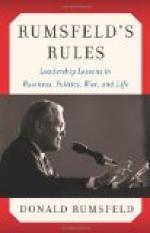The great object was to strike down Cronje’s force before it could receive help, and the design must have been to cut off his retreat to the eastward. On Thursday, the 15th, French marched from the Modder to Alexandersfontein, attacked the rear of the Boer line investing Kimberley, and in the evening entered the town. He had left the sixth division at the drifts of the Modder. This movement of French’s appeared to imply that Cronje’s army was known to be retreating to the west or north-west, and that French took the road through Kimberley as the shortest way to reach a position where that retreat could be intercepted. It could hardly be imagined that the move was made for the sake of Kimberley, of which the relief was assured whether Cronje stood to fight or retreated in any direction. The essential thing was to find where Cronje’s force was—if it was at Magersfontein to surround it or drive it to the west; if elsewhere to delay it with the cavalry and pursue it with the infantry. But Cronje was not found. When French was in Kimberley, Cronje, retreating eastwards, passed through the fifteen miles gap between the town and Kelly-Kenny. Kelly-Kenny on Friday discovered this and set off in pursuit while French was following a Boer force retreating northwards, probably part of the force that had invested Kimberley. Kelly-Kenny shelled the Boer laager and captured a number of waggons, but the Boers retreated eastwards along the north bank of the Modder with Kelly-Kenny at their heels. To assist Kelly-Kenny French was recalled from the north, and Macdonald with the Highland Brigade pushed out by a forced march from Jacobsdal. Accounts differ as to the site of the fighting, but there was a three days’ running fight, during which Cronje may have crossed the Modder and approached Paardeberg or may have been stopped on the north bank. The Boer reports, which imply at least that Cronje was hard pressed, were sent off before the finish, and the first British official reports, consisting only in a list of officers killed and wounded, show that each of the three infantry brigades had hard fighting with considerable losses.
Of eight infantry brigades with which Lord Roberts began his movement three were engaged against Cronje; one has probably been sent to Kimberley, with which town railway communication has been re-opened, so that it will be soon an advanced base for the Army. Lord Roberts, therefore, who was at Paardeberg on Monday evening, may have had with him four brigades or two divisions, representing twenty thousand men, besides the three brigades engaged, which represented before the battle something like fifteen thousand.
Of French and the cavalry division there is no report. The Boers publish a telegram from Commandant de Wet, who seems to have brought up reinforcements while Cronje’s action was in progress on Sunday.




